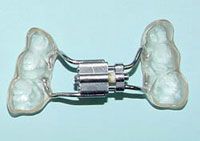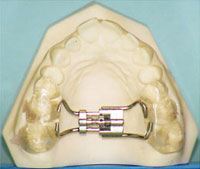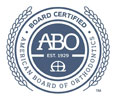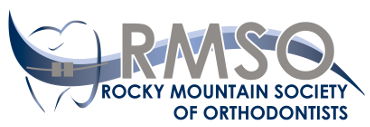Expanders

A typical “bonded” Expander.
Many young patients have upper and lower jaws which do not fit together. Probably the most common issue related to a poor fitting bite is a narrow upper jaw relative that patient’s lower jaw. This narrowness can be caused from overactive muscles of the face restricting the upper jaw development, genetics (i.e., mom’s upper jaw and dad’s lower jaw), and/or mouth-breathing (when a patient’s nasal air passages are blocked frequently enough to prevent breathing through the nose). Mouth breathing is particularly common in regions with higher than average allergens. When a patient breathes through their mouth, the tongue rests on the floor of the mouth while the cheeks push inward from the sides, thus constricting the upper arch of teeth. Compare this to breathing through the nose which requires the tongue to be raised against the roof of the mouth, behind and against all of the front teeth. With the support of the tongue against the inside of the upper teeth, the force from the cheek muscles is balanced and there is no tooth movement or resistance to growth.

Expander as it fits on teeth.
Once the upper jaw is too narrow to fit well with the lower jaw (termed a crossbite), the lower jaw will normally shift to one side or the other so at least some of the back teeth fit well. If this shift remains throughout growth, the lower jaw can begin to grow more sideways and become asymmetric. This is the reason crossbites are corrected as soon as possible after the permanent first molars erupt, around age six to seven. Additionally, expansion is performed by pushing two bones of the upper jaw away from each other and allowing bone to form in the middle. The upper jaw bones are easily moved as a child, but fuse in the late teens making expansion increasingly less successful as the child becomes an adult..
Expansion can be successfully performed in all patients up to age 15 (although side effects from years of ill-fitting jaws may not be easily reversible). Past age 15, the bones of the upper face begin to fuse and it becomes more difficult to expand the upper jaw. After 18, most patients will require surgery for expansion (the surgery simply re-opens the space that used to exist between the bones).





